Abstract
A system for simultaneous 24-hour tape recording of ECG and respiration has been developed and used in the study of 4 groups of newborn infants. In 50 randomly selected, healthy term infants, the mean lowest heart rate (>9 beats' duration; was 88 ± 13. 14 (28%) infants had junctional escape rhythms, 5 had supraventricular, and 2 ventricular premature beats. 34 (68%) subjects had apnoeic episodes ≥10 seconds' duration; the 95th centile for maximum duration of apnoea was 18 seconds, the longest episode being 28 seconds. Episodes of bradycardia <100/minute were associated with 50 of a total of 288 episodes of apnoea of 10-14 seconds, with all 4 episodes of 15-19 seconds, and with both episodes ≥20 seconds.
In 100 randomly selected, healthy, preterm or low birthweight infants studied within 5 days of their discharge from hospital, the mean lowest heart rate was 91 ± 18. 18 had junctional, one idioventricular, and 3 both junctional and idioventricular escape rhythms. Two had supraventricular and 6 had ventricular premature beats. 66 subjects had apnoeic episodes ≥10 seconds' duration; the 95th centile for maximum duration of apnoea was 20 seconds, the longest episode being 52 seconds. Episodes of bradycardia <100/min were associated with 84 of a total of 608 episodes of apnoea 10-14 seconds' duration, with 21 of 37 episodes of 15-19 seconds, and with 15 of 15≥20 seconds. One preterm infant with a maximum apnoeic episode of 52 seconds had an associated bradycardia of 27/min.
Three of 5 `near-miss' cot death infants and one preterm infant with a family history of cot death studied immediately before discharge showed prolonged apnoea >40 seconds, or extreme bradycardia <50/min, or both.
Finally, 11 infants with arrhythmias on a standard ECG were studied. Of these, 6 with premature beats and 3 of 5 with episodes of bradycardia did not exhibit apnoea during arrhythmias. Two of the 5 babies with bradycardia however, demonstrated associated apnoea of 10-14 seconds.
There may be a relationship between latent episodes of prolonged apnoea and bradycardia and hypoxaemic brain damage or sudden infant death.
Full text
PDF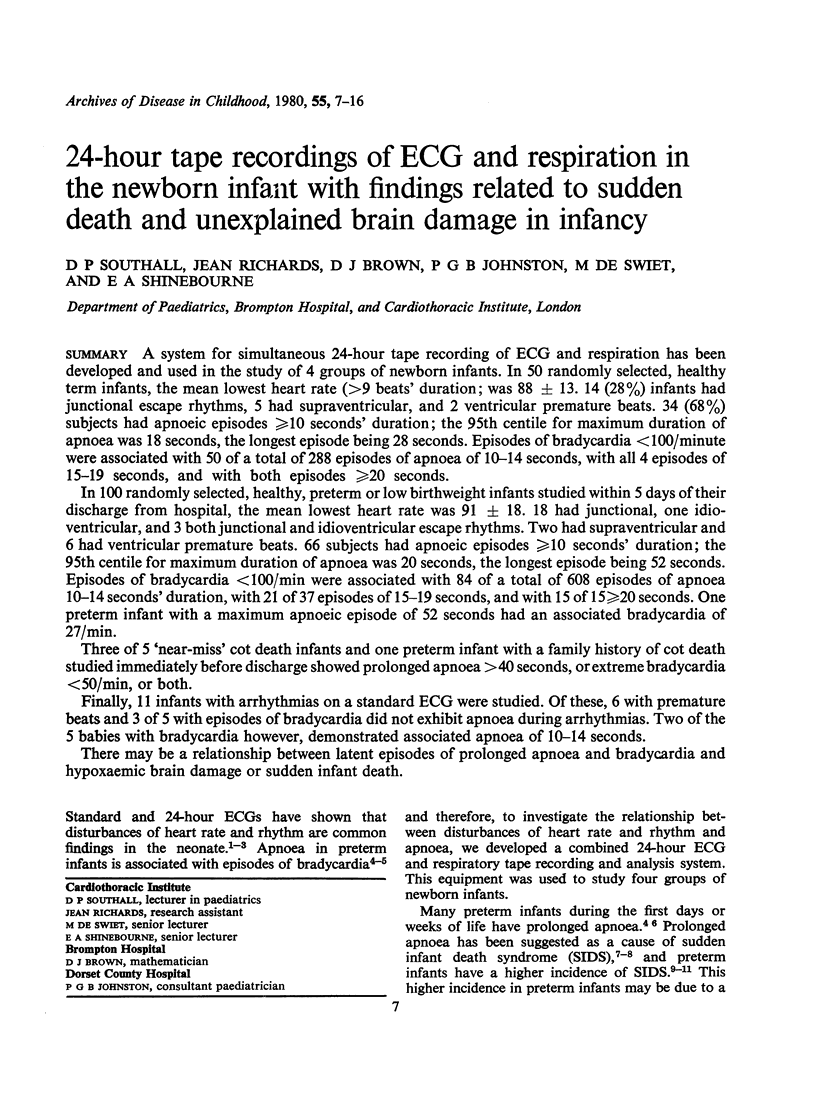
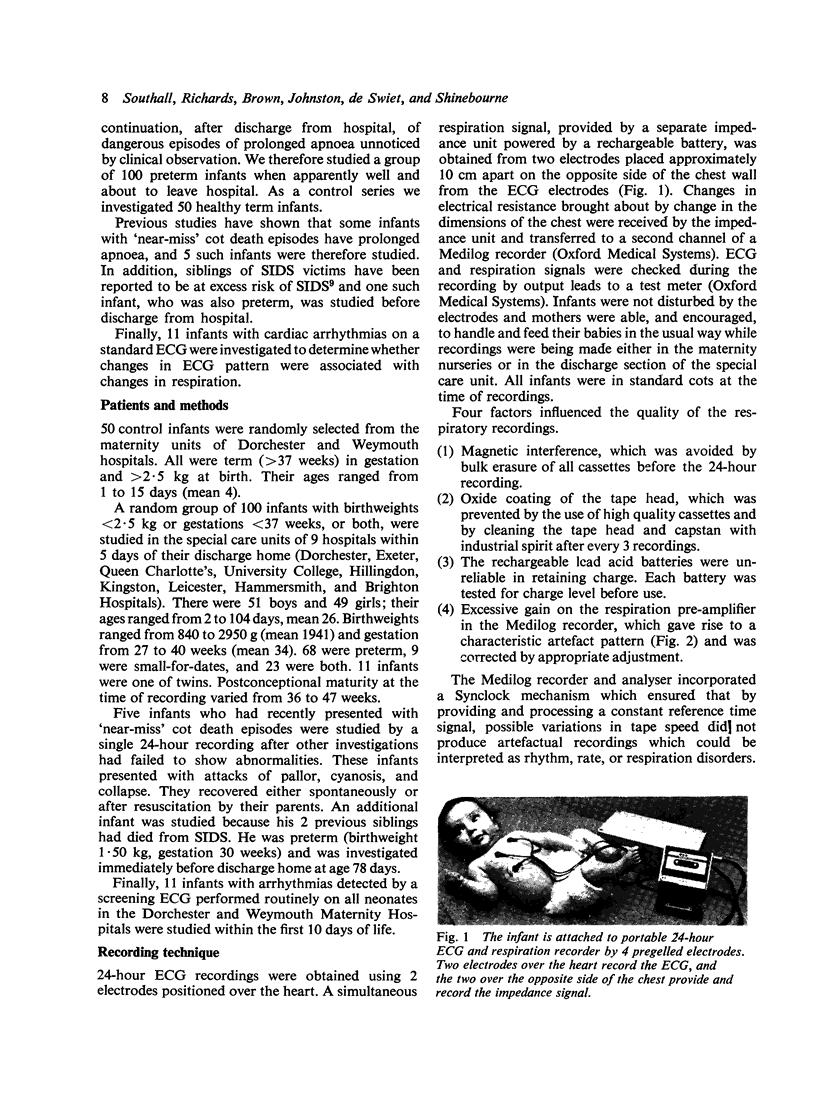
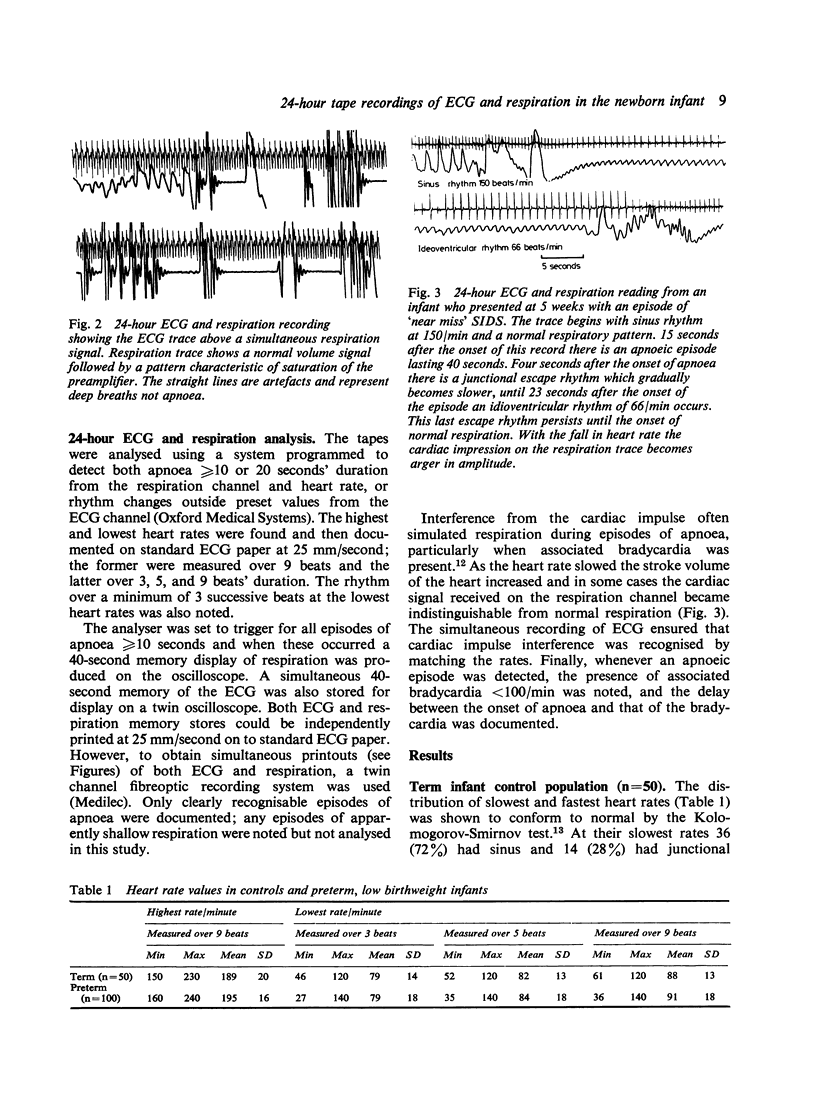
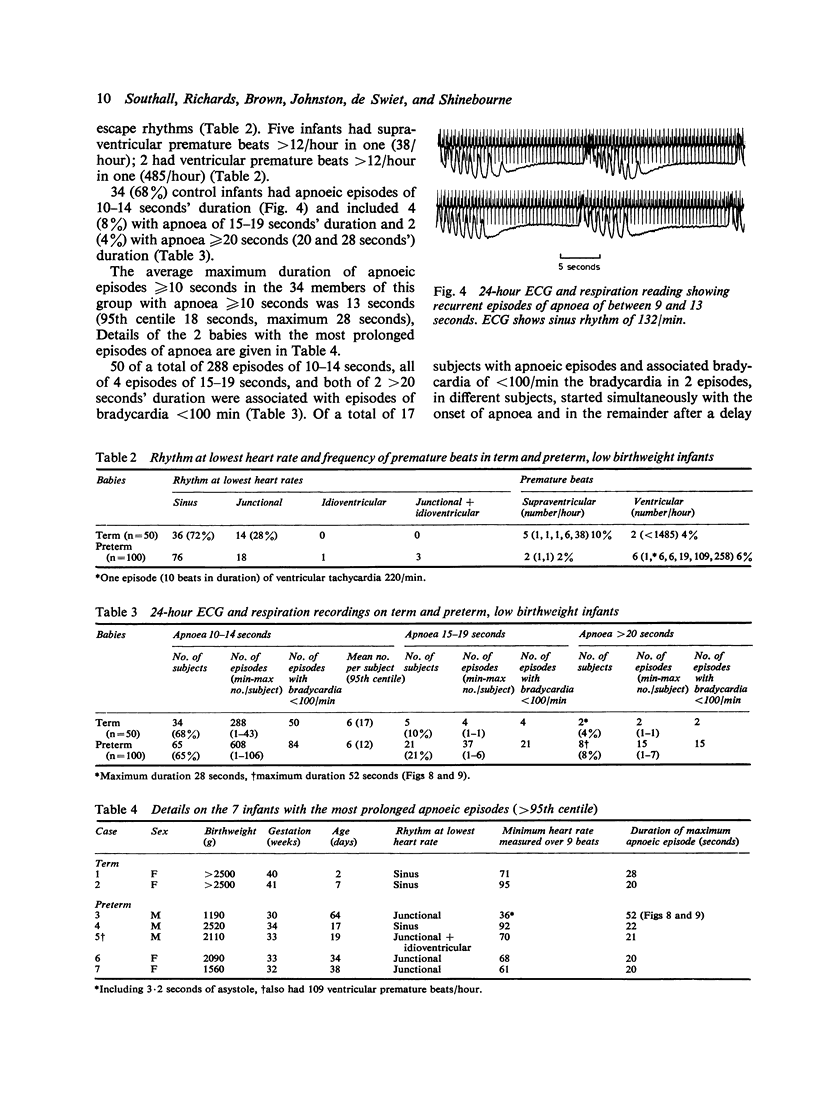
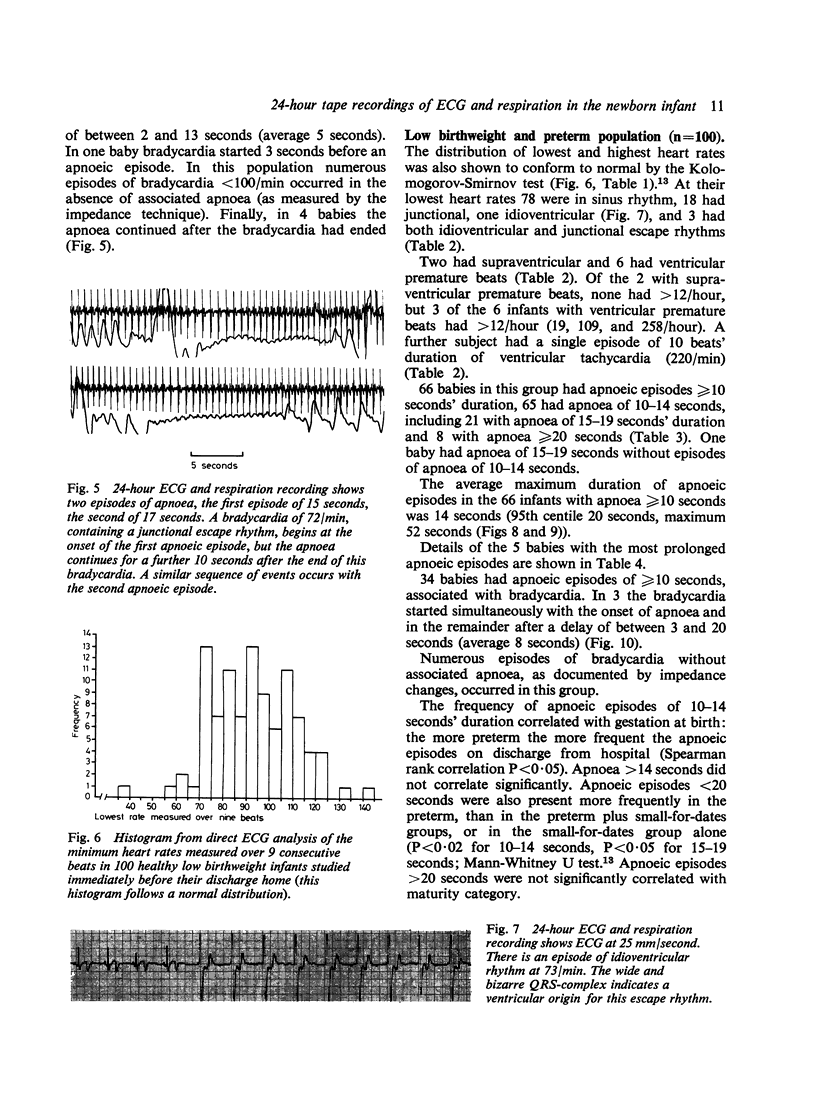
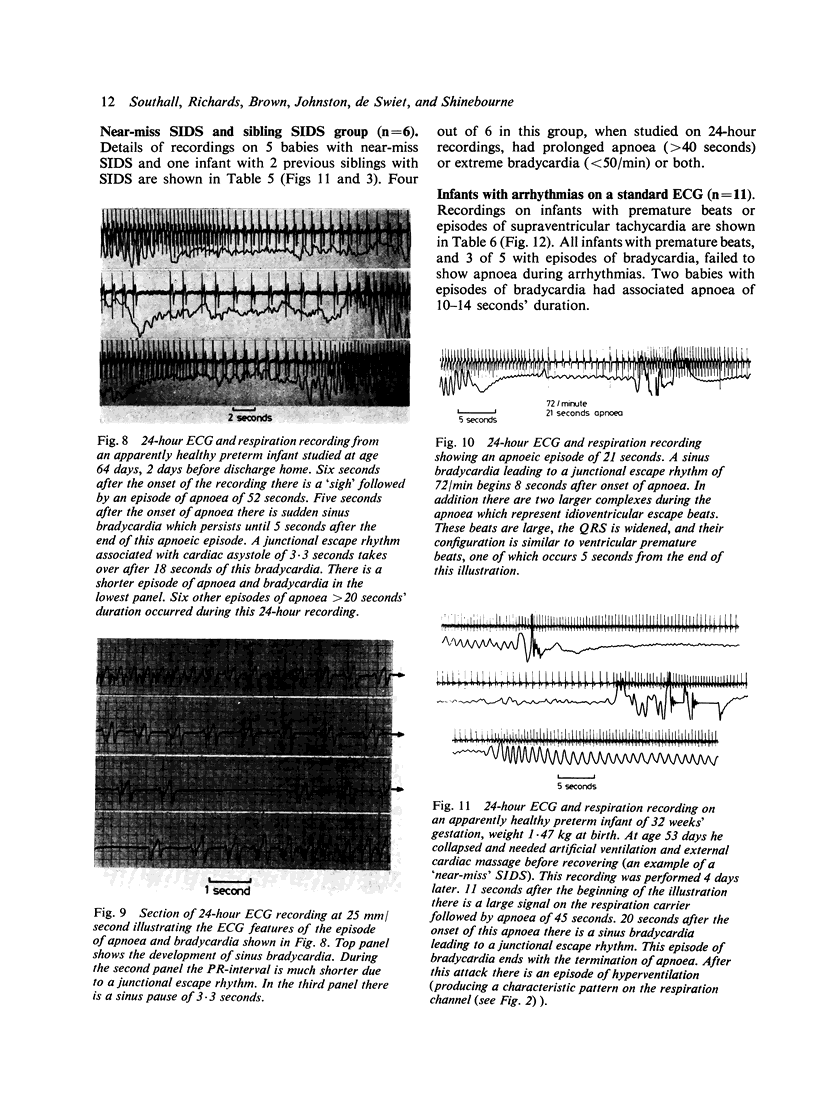
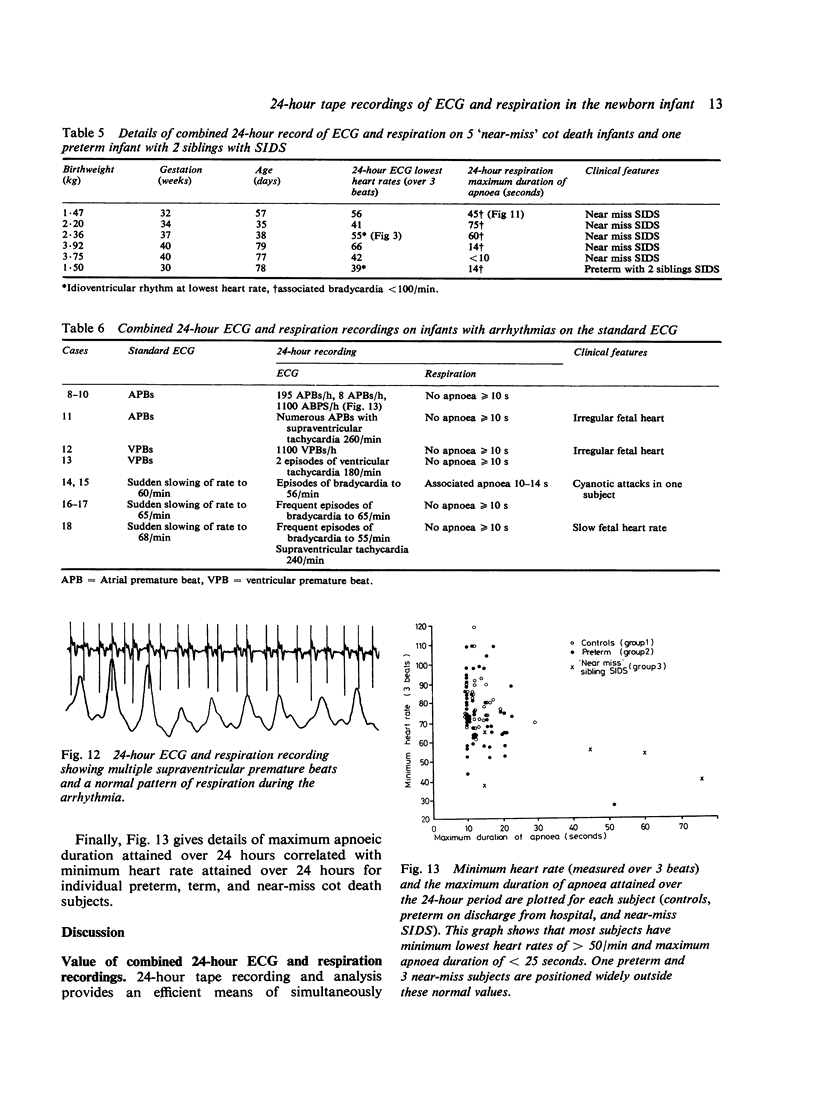
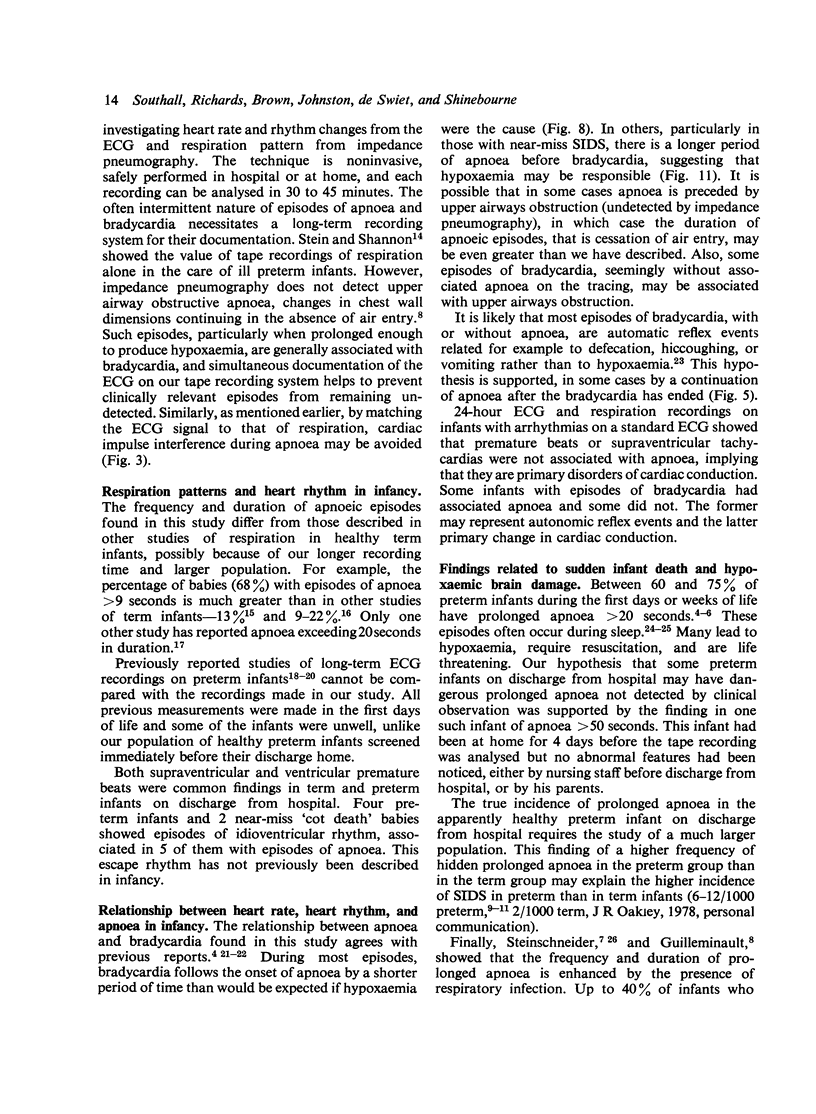
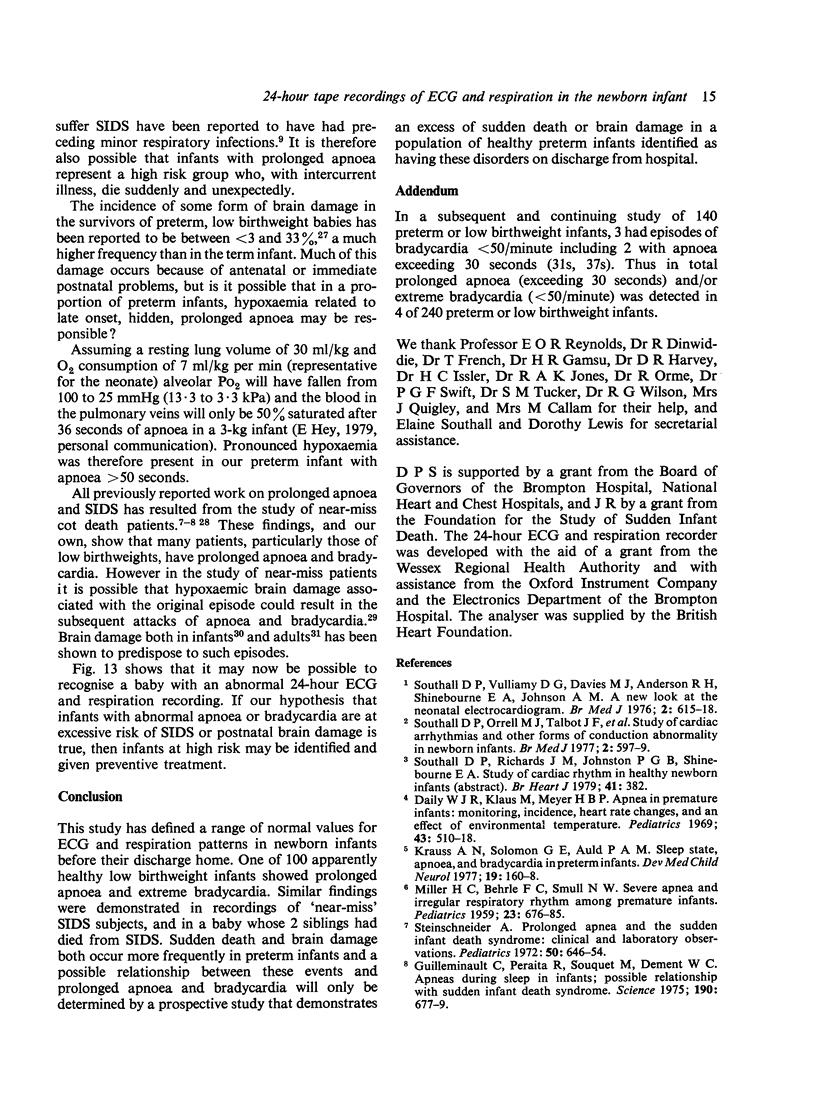
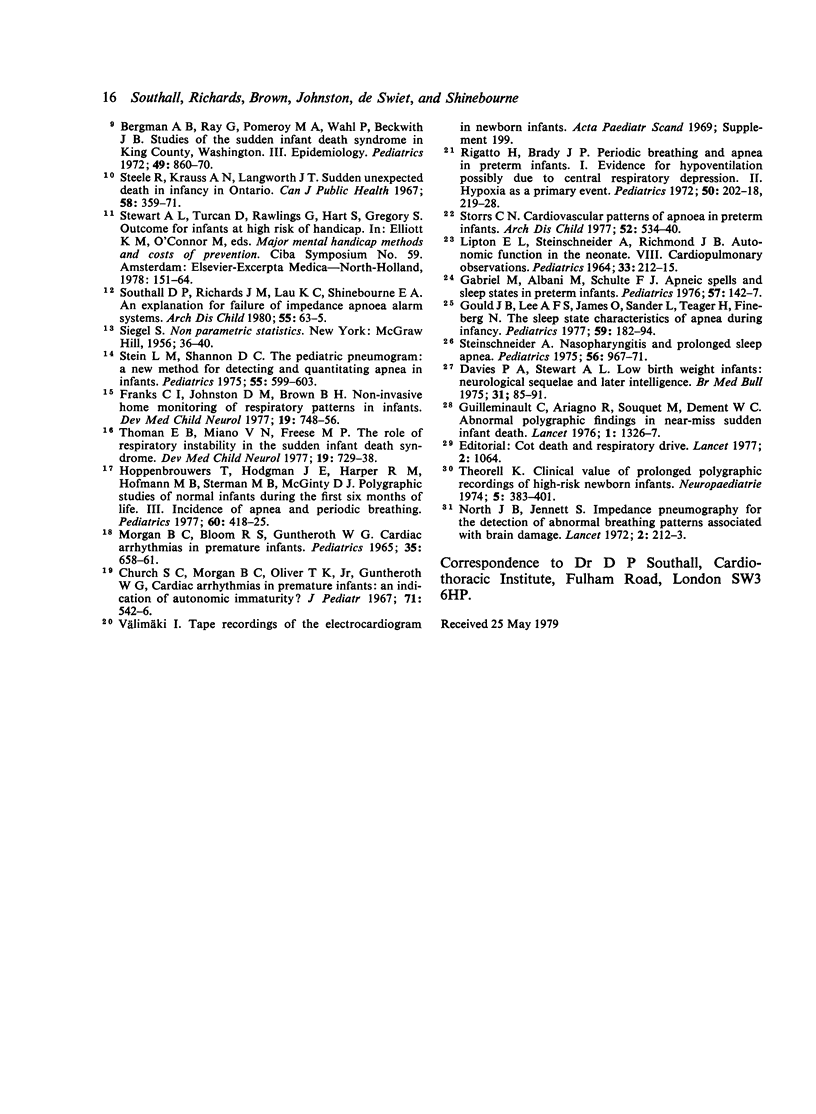
Images in this article
Selected References
These references are in PubMed. This may not be the complete list of references from this article.
- Church S. C., Morgan B. C., Oliver T. K., Jr, Guntheroth W. G. Cardiac arrhythmias in premature infants: an indication of autonomic immaturity? J Pediatr. 1967 Oct;71(4):542–546. doi: 10.1016/s0022-3476(67)80105-7. [DOI] [PubMed] [Google Scholar]
- Daily W. J., Klaus M., Meyer H. B. Apnea in premature infants: monitoring, incidence, heart rate changes, and an effect of environmental temperature. Pediatrics. 1969 Apr;43(4):510–518. [PubMed] [Google Scholar]
- Davies P. A., Stewart A. L. Low-birth-weight infants: neurological sequelae and later intelligence. Br Med Bull. 1975 Jan;31(1):85–91. doi: 10.1093/oxfordjournals.bmb.a071248. [DOI] [PubMed] [Google Scholar]
- Gabriel M., Albani M., Schulte F. J. Apneic spells and sleep states in preterm infants. Pediatrics. 1976 Jan;57(1):142–147. [PubMed] [Google Scholar]
- Gould J. B., Lee A. F., James O., Sander L., Teager H., Fineberg N. The sleep state characteristics of apnea during infancy. Pediatrics. 1977 Feb;59(2):182–194. [PubMed] [Google Scholar]
- Guilleminault C., Ariagno R., Souquet M., Dement W. C. Abnormal polygraphic findings in near-miss sudden infant death. Lancet. 1976 Jun 19;1(7973):1326–1327. doi: 10.1016/s0140-6736(76)92656-8. [DOI] [PubMed] [Google Scholar]
- Guilleminault C., Peraita R., Souquet M., Dement W. C. Apneas during sleep in infants: possible relationship with sudden infant death syndrome. Science. 1975 Nov 14;190(4215):677–679. doi: 10.1126/science.1188364. [DOI] [PubMed] [Google Scholar]
- Hoppenbrouwers T., Hodgman J. E., Harper R. M., Hofmann E., Sterman M. B., McGinty D. J. Polygraphic studies of normal infants during the first six months of life: III. Incidence of apnea and periodic breathing. Pediatrics. 1977 Oct;60(4):418–425. [PubMed] [Google Scholar]
- Krauss A. N., Solomon G. E., Auld P. A. Sleep state, apnea and bradycardia in pre-term infants. Dev Med Child Neurol. 1977 Apr;19(2):160–168. doi: 10.1111/j.1469-8749.1977.tb07965.x. [DOI] [PubMed] [Google Scholar]
- LIPTON E. L., STEINSCHNEIDER A., RICHMOND J. B. AUTONOMIC FUNCTION IN THE NEONATE. VIII. CARDIO-PULMONARY OBSERVATIONS. Pediatrics. 1964 Feb;33:212–215. [PubMed] [Google Scholar]
- MILLER H. C., BEHRLE F. C., SMULL N. W. Severe apnea and irregular respiratory rhythms among premature infants; a clinical and laboratory study. Pediatrics. 1959 Apr;23(4):676–685. [PubMed] [Google Scholar]
- MORGAN B. C., BLOOM R. S., GUNTHEROTH W. G. CARDIAC ARRHYTHMIAS IN PREMATURE INFANTS. Pediatrics. 1965 Apr;35:658–661. [PubMed] [Google Scholar]
- North J. B., Jennett S. Impedance pneumography for the detection of abnormal breathing patterns associated with brain damage. Lancet. 1972 Jul 29;2(7770):212–213. doi: 10.1016/s0140-6736(72)91639-x. [DOI] [PubMed] [Google Scholar]
- Rigatto H., Brady J. P. Periodic breathing and apnea in preterm infants. I. Evidence for hypoventilation possibly due to central respiratory depression. Pediatrics. 1972 Aug;50(2):202–218. [PubMed] [Google Scholar]
- Southall D. P., Orrell M. J., Talbot J. F., Brinton R. J., Vulliamy D. G., Johnson A. M., Keeton B. R., Anderson R. H., Shinebourne E. A. Study of cardiac arrhythmias and other forms of conduction abnormality in newborn infants. Br Med J. 1977 Sep 3;2(6087):597–599. doi: 10.1136/bmj.2.6087.597. [DOI] [PMC free article] [PubMed] [Google Scholar]
- Southall D. P., Richards J. M., Lau K. C., Shinebourne E. A. An explanation for failure of impedance apnoea alarm systems. Arch Dis Child. 1980 Jan;55(1):63–65. doi: 10.1136/adc.55.1.63. [DOI] [PMC free article] [PubMed] [Google Scholar]
- Southall D. P., Vulliamy D. G., Davies M. J., Anderson R. H., Shinebourne E. A., Johnson A. M. A new look at the neonatal electrocardiogram. Br Med J. 1976 Sep 11;2(6036):615–618. doi: 10.1136/bmj.2.6036.615. [DOI] [PMC free article] [PubMed] [Google Scholar]
- Steele R., Kraus A. S., Langworth J. T. Sudden, unexpected death in infancy in Ontario. I. Methodology and findings related to the host. Can J Public Health. 1967 Aug;58(8):359–364. [PubMed] [Google Scholar]
- Stein I. M., Shannon D. C. The pediatric pneumogram: a new method for detecting and quantitating apnea in infants. Pediatrics. 1975 May;55(5):599–603. [PubMed] [Google Scholar]
- Steinschneider A. Nasopharyngitis and prolonged sleep Apnea. Pediatrics. 1975 Dec;56(6):967–971. [PubMed] [Google Scholar]
- Steinschneider A. Prolonged apnea and the sudden infant death syndrome: clinical and laboratory observations. Pediatrics. 1972 Oct;50(4):646–654. [PubMed] [Google Scholar]
- Stewart A., Turcan D., Rawlings G., Hart S., Gregory S. Outcome for infants at high risk of major handicap. Ciba Found Symp. 1978;(59):151–171. doi: 10.1002/9780470720417.ch9. [DOI] [PubMed] [Google Scholar]
- Storrs C. N. Cardiovascular effects of apnoea in preterm infants. Arch Dis Child. 1977 Jul;52(7):534–540. doi: 10.1136/adc.52.7.534. [DOI] [PMC free article] [PubMed] [Google Scholar]
- Theorell K. Clinical value of prolonged polygraphic recordings in high-risk newborn infants. Neuropadiatrie. 1974 Nov;5(4):383–401. doi: 10.1055/s-0028-1091719. [DOI] [PubMed] [Google Scholar]



